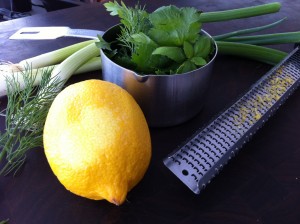The Pinch Of Salt
 I hit a wall last week. My mother had surgery, and in the aftermath told me that she’s now on a low-sodium diet, doctor’s orders.
I hit a wall last week. My mother had surgery, and in the aftermath told me that she’s now on a low-sodium diet, doctor’s orders.
When people I love are ailing, my impulse has always been to cook for them. Making a pot of chicken soup or even just preparing a nice tray with buttered toast and ginger ale gives me a productive way to cope with the helplessness I feel in the face of their discomfort. But when my mom announced she had to cut salt out of her diet, I went completely blank. I literally could not think of a single dish to brighten her exile.
It startled me to realize I had come to such an impasse. After all, I have created food for all kinds of impossible eaters: Lactose-intolerant carnivores, gluten-free vegans, gluten-free non-vegans, the nightshade-averse, the allergic-to-everything, and enough picky children to fill a CAFO. In fact, I cooked for nearly all of the above every day at camp last summer, and, yes, trying to keep it all straight made my head hurt. So why should a low-salt diet confound me?
Of course, I didn’t tell my mother how I was feeling. What I said was, “Great, okay, cool, no problem. Once you get used to it, you won’t even notice.” But inside, I was panicking. I mean, I love salt. I even add an extra pinch to cookie dough—and candy batter!—to balance the sweetness and add complexity and structure to the flavor.
My younger sister has a friend who does not consider her food salty enough unless she can feel the crystals crunching in her teeth when she chews. I’m not that bad—and this fact alone gives me comfort: Perhaps it means that I’m not actually bad at all, but rather somewhere on the salty side of good!
I further justify my habit by telling myself that my family eats hardly any processed foods—the great malefactors when it comes to sodium content—and that trimming the salt from my home cooking may not be, scientifically speaking, necessary. The medical establishment has demonstrated that a low-salt diet is of clear value to people suffering from hypertension, kidney disease, and diabetes. But for the rest of us, the jury is out. Salt has health benefits, and a few rogue dieticians are now saying that too little salt may be as harmful as too much. Maybe cutting salt from our diets is like wearing compression stockings when we don’t actually have phlebitis. Maybe it’s overkill.
Do I sound defensive? Because I am feeling a little bit defensive about my addiction here.
Anyway, sitting by my mother’s hospital bed that day, I finally managed to snap out of my catatonia. She was dictating a shopping list to me—no-salt soup, no-salt crackers, prune juice, milk—when a gear clicked and I suddenly remembered the many herb pastes I’ve made over the years. Yes, all of them contained salt, but salt wasn’t the key to their flavor. That came instead from the freshness of the herbs, the zing of lemon zest, the bite of raw garlic or ginger, the swoony lusciousness of coconut milk. I’ve slathered such pastes on fritters and fish, on grilled leeks and roasted roots. I’ve swirled them into lamb stews and whisked them into salad dressings. They’ve always worked magic, adding vitality and brightness, and balancing all the deep, rich, caramelized flavors of cooked foods. I figured they’d do the same for canned soups and boiled vegetables.
Back home, I whipped up a couple such sauces for my mom. I had enough leftover of one to fill a small jar, so I did, and tucked it away in my fridge. All week, I added a bit to this and that, eating in solidarity with my convalescing mother. Except I cheated: Unlike hers, mine included half a teaspoon of salt.
Green Sauce
This is a great way to use up any leftover fresh herbs that might otherwise languish in your fridge. You can add this sauce to just about anything, from roast chicken to mayonnaise, or use it to bring leftover stews and soups back to life.
1 cup total fresh parsley, mint, dill, basil and/or cilantro, in any combination
1 tablespoon capers
3 scallions, roughly chopped
1 clove garlic, chopped, optional
1-2 tablespoons fresh lemon juice
grated zest of 1 lemon (yellow part only)
1-2 tablespoons olive oil
¼ teaspoon sea salt (100% completely optional!)
Combine all ingredients in a food processor and mix until a paste forms—if you like it rough, pulse quickly, or let it go longer for a smoother result. Transfer to a jar and store up to 5 days in the refrigerator, adding a little extra oil to the top each time you use it to keep the herbs from browning. Or freeze in ice-cube trays; when solid, transfer cubes to a freezer-safe plastic bag to store.